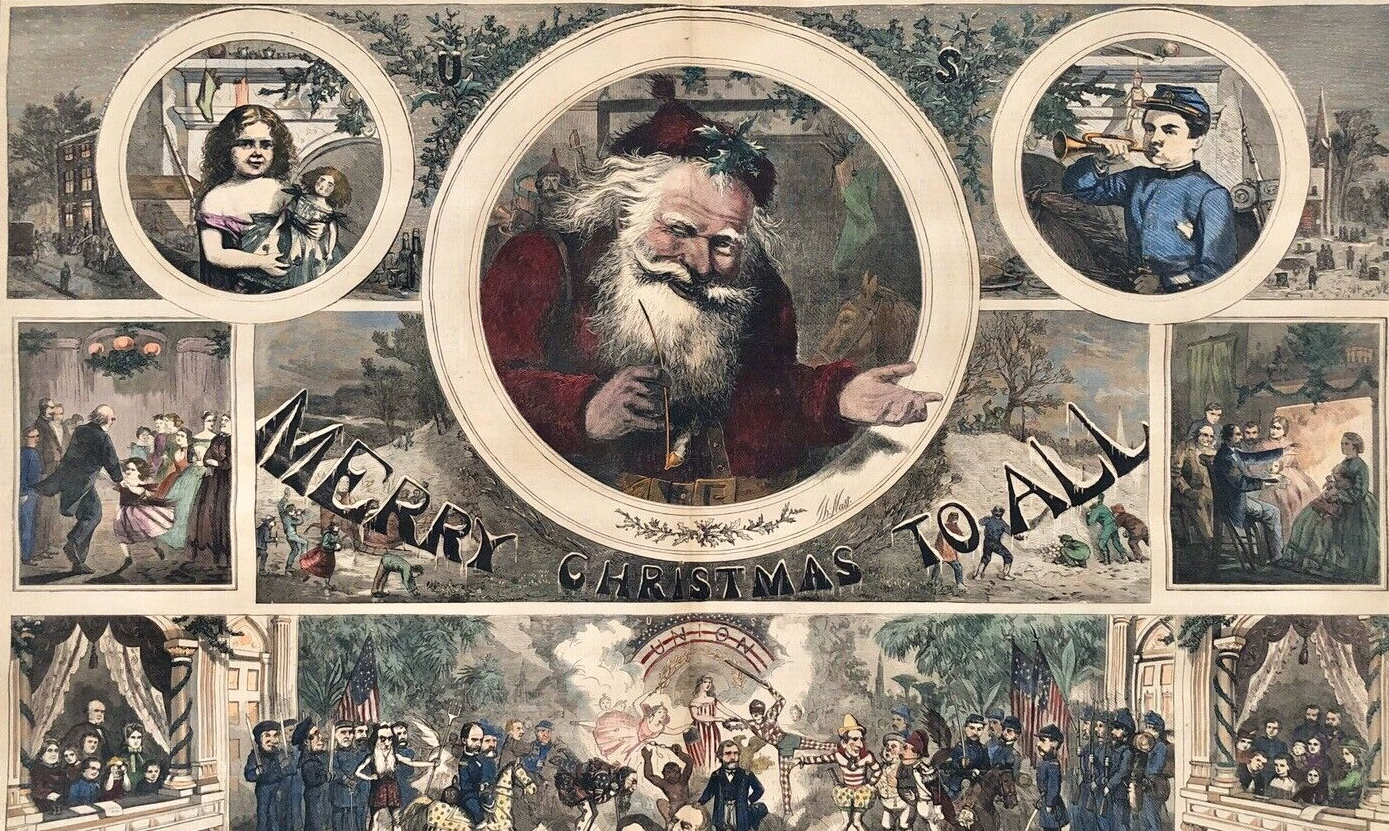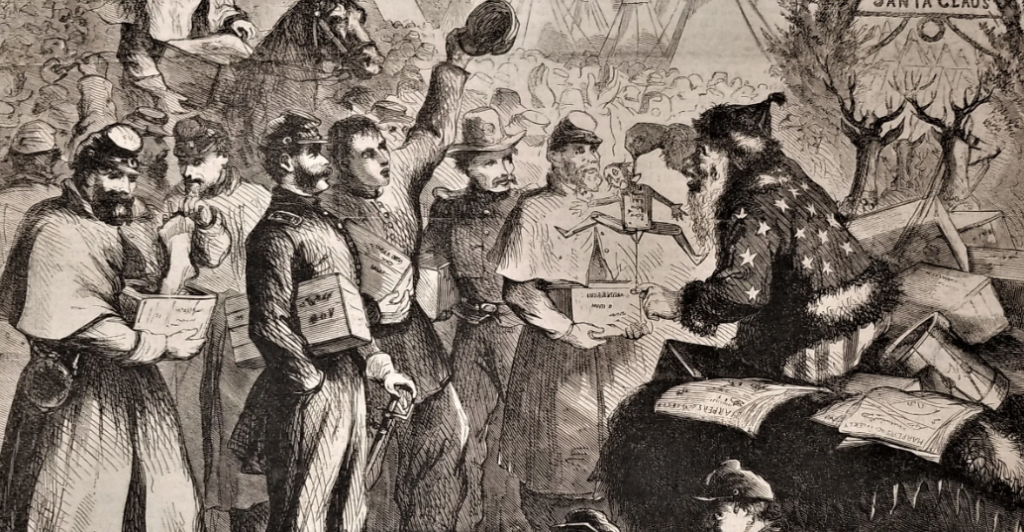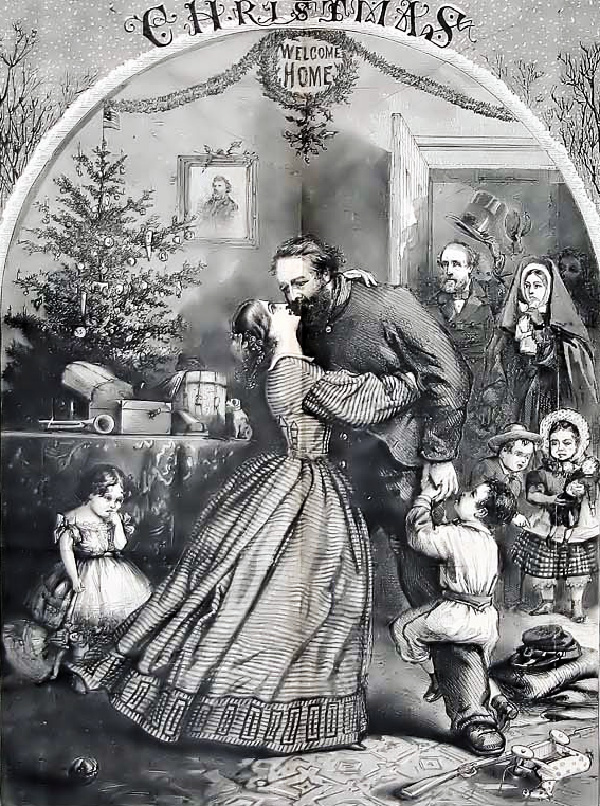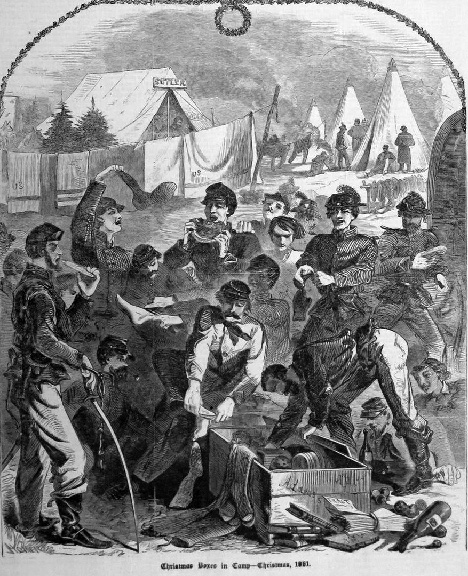
Christmas Traditions During the Civil War
December 19, 2023When enjoying a December visit to historic Gettysburg, Pennsylvania, and touring its hallowed environs now dressed for the season and bedecked in holiday splendor, one finds oneself surrounded at every turn by the echoes of the Civil War and its effect on our nation. Delving into the curious intersection of Christmas traditions and wartime history, one might also ponder how the celebration of our modern holiday season was forever influenced by those tumultuous times.
The events of the American Civil War had a profound impact on shaping and influencing our Christmas traditions, with the hardships and turmoil of the time leading to the development of many enduring customs and their adaptations. Here are some examples of how the Civil War left its mark on American Christmas traditions:
Celebrations on the Home Front
Although not acknowledged as an official federally-ordained national holiday before the Civil War, by the mid-19th century, the popularity of the holiday had begun to grow.
Iconic tunes such as “Jingle Bells” (1857) and the classic poem “A Visit from St. Nicholas” (1823) had become ingrained in the collective awareness of the nation, spawning popular traditions and a new appreciation for the old holiday, now centered on gift-giving, feasting, and family celebrations to signify the culmination of the year.
But the onset of war in 1861 changed that. Families separated by war had to find creative ways to celebrate Christmas despite the absence of loved ones. The exchange of small, meaningful gifts, handmade ornaments, and letters became cherished traditions, fostering a sense of connection and normalcy amid the challenging circumstances.
Battlefield Celebrations
Despite the dreadful toll taken on human life throughout the conflict, the Christmas season sometimes allowed combatants rare moments of peace, where soldiers shared food, sang carols, and even exchanged gifts, emphasizing the universal desire for goodwill and camaraderie. On the battlefield itself, men on both sides tried to celebrate Christmas by giving gifts, eating and drinking, and taking time off. James A. Wright, a sergeant in the First Minnesota Volunteer Infantry Regiment, wrote in his memoir about eating beef soup, and about greeting his fellow soldiers in camp on Christmas: “The men had been allowed as much liberty as consistent with discipline and were ‘circulating around’ among their acquaintances in other regiments,” he reported. “I was frequently invited to ‘smile,’” or take a drink. A Confederate soldier wrote home to his mother in North Carolina, requesting she send him a bottle of brandy and enough sugar to enable him to make a batch of eggnog for his comrades at arms.
Christmas Trees and Decorations
The introduction and popularization of Christmas trees in America can be traced back to the mid-19th century. The Civil War era saw a huge surge in the use of Christmas trees, which had become popular in the decade before the Civil War, and in the early 1860s, many families were beginning to decorate them. Artists who illustrated many of the most widely-viewed weekly national newspapers and magazines helped popularize the practice by depicting decorated, table-top-sized Christmas trees in their drawings. The declaration of war did little to diminish the nation’s new fervor for decorating indoor Christmas trees.
Even while suffering under the deprivations of blockades, rationing, and home front shortages, families at home still took active part in the new tradition, making do with what they had to create homemade ornaments and decorations crafted from bits and bobs they could scrounge or repurpose or were mostly decorated with different kinds of pines, holly, ivy, and mistletoe. Most trees were small and sat on a table, decorated with strings of dried fruit, popcorn, and pinecones.
Naturally, the new tradition also found its way into tents and military encampments on both sides of the battle lines, where soldiers adorned them with rations, rare sweet treats, and fruit. One soldier, Alfred Bellard of the 5th New Jersey, recorded his reaction to the impromptu appearance of the recently popular Christmas decoration at his unit’s encampment near the lower Potomac River, writing “In order to make it look much like Christmas as possible, a small tree was stuck up in front of our tent, decked off with hard tack and pork, in lieu of cakes and oranges, etc.”
This adaptation of holiday décor reflected a resourcefulness born out of necessity, manifesting a vital cultural insistence on celebrating its blessed holidays however it could do so.
Santa Claus and the American Civil War
While our modern Santa Claus may not have originated during the Civil War, there’s an interesting connection between the image of Santa and the emotional needs of a nation torn in two. Thomas Nast, a prominent political cartoonist of the time, played a crucial role in shaping the modern depiction of Santa. His work proved to be so powerful and endearing that the overall idea of Santa Claus would eventually come to transcend the political biases of the day to become a powerful symbol of comfort, as well as a reminder of the enduring spirit of generosity and goodwill.
 Thomas Nast’s Civil War Santa
Thomas Nast’s Civil War Santa
Thomas Nast, a 19th-century illustrator and political cartoonist, played a significant role in shaping the modern image of Santa Claus and, notably, used his iconic depiction of this beloved figure as a powerful political symbol during the Civil War. Nast’s illustrations, featured in Harper’s Weekly magazine, began as thinly veiled wartime propaganda and portrayed Santa Claus as a patriotic figure, sometimes clad in soldier’s attire or bedecked in American stars and stripes, using the character to convey messages of national solidarity, hope, and unity during a tumultuous time.
Nast’s wartime depictions of Santa often featured him visiting Union troops on the front lines, delivering gifts and joy to soldiers far from home. By incorporating Santa into his illustrations, Nast aimed to boost morale and convey a sense of normalcy during the holiday season, even in the midst of conflict. Nast’s Santa became a symbol of solidarity and good humor for those on the home front, encapsulating an enduring spirit of goodwill and generosity that transcended the challenges of war.
His depiction of Santa Claus as a smiling, white-bearded, jolly round figure would become the standard. However, this was wartime; Nast was a notable and influential political cartoonist of the day— so his earliest depictions of Santa feature satirical pro-Union propaganda elements, lending them a somewhat dark undertone. In one cartoon, for instance, Santa is seen holding a marionette puppet— obviously modeled after the image of Confederate President Jefferson Davis— with a string wrapped around his neck! But as time passed, Nast’s cartoon Santa became less overtly political and more generally beloved as a symbol of the season.
At war’s end, Nast continued to use his annual Christmas Santa illustrations to influence the popular political sentiment of the day, now depicting a friendly Santa welcoming both Union troops as well as defeated former Confederate soldiers home from the battlefields at long last, greeting them together in a sign of goodwill and rekindled solidarity. This notable public gesture was a remarkable statement of forgiveness in the wake of the long struggle.
In this way, Thomas Nast used Santa Claus as a powerful symbol, infusing the wartime narrative by emphasizing the importance of hope and togetherness in the face of adversity, both in the midst and during the aftermath of a terrible national conflict.
How Else Did the Civil War Influence Christmas Traditions?
As we explore the intricate relationship between the Civil War and Christmas, one might wonder how exactly the conflict influenced holiday traditions. The war brought unprecedented challenges, but it also sparked a wave of creativity and adaptation in how people celebrated Christmas.
The Civil War era marked a time of hardship and separation for many families. With loved ones fighting on distant battlefields, the warmth of the holiday season took on a new significance. Families on the home front embraced creative ways to connect with their absent soldiers. Care packages, letters, and even makeshift celebrations became ways to maintain a sense of normalcy and spread a bit of holiday cheer in challenging times.
Moreover, the war gave rise to unique Christmas traditions that reflected the era’s spirit. Soldiers exchanged small gifts, crafted ornaments from materials at hand, and even celebrated impromptu truces, setting aside hostilities to share moments of peace during the holiday season. The resilience displayed during these trying times laid the foundation for the enduring spirit of hope and togetherness that we cherish in our modern celebrations.
Our Holiday Traditions, and How They Endure
The Civil War era not only shaped our perception of Santa Claus but also laid the groundwork for other Christmas traditions that have become integral to our celebrations today. From the introduction of Christmas cards to the popularization of Christmas trees, the 19th century saw a transformation in how we celebrate the holidays. Exploring these historical roots provides a fascinating perspective on the evolution of our festive customs and the ways in which our ancestors found joy and meaning in the midst of challenges.
As you gather around the holiday table or exchange gifts this season, it might be gratifying to consider where some of our most beloved holiday traditions originated and how they were subtly altered and tempered by the mighty events and great conflicts that forever defined the character of our great nation… none so powerfully or enduringly as the American Civil War.
A richer understanding of these tales contributes to the collective appreciation of our cultural heritage while connecting us through the tales and stories that bind us across time. Happy holidays, and may your celebrations be filled with the warmth of tradition and the joy of our shared cultural heritage.
Visit Gettysburg in Person
Plan your next excursion with us! Our bus tours of the historic Gettysburg Battlefield are active and ready to show you the sites of the historical battleground. Reservations can be made by calling our toll-free number at 877-680-8687. You can also purchase bus tour tickets online. Tours depart from the Gettysburg Tour Center located at 777 Baltimore St., Suite 100.


